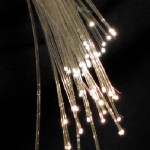2009 Nobel Prize in Physics goes to Kao, Smith and Boyle
 Telecommunications were the subject of the 2009 Nobel Prize in Physics. This year’s award will be split between two discoveries that have had a broad impact on contemporary life – fiber optics and charge-coupled device (CCD) technology.
Telecommunications were the subject of the 2009 Nobel Prize in Physics. This year’s award will be split between two discoveries that have had a broad impact on contemporary life – fiber optics and charge-coupled device (CCD) technology.
Charles Kuen Kao will receive half the Prize for laying the foundations of the modern fiber optic industry. In 1966, he calculated how to transmit light signals over long distances using glass fibers. To that point, traditional materials had only been capable of transmitting signals over short distances (i.e. 50 feet). Kao’s discovery demonstrated how to send signals over many miles. Four years later, the first ultrapure glass fiber was built, increasing signal transmission by an order of magnitude of several thousand. Today, optic fibers are everywhere, and fuel Internet technologies that allow us to receive video, images, and sounds in microseconds. His discovery has had a profound impact on how creating the digital age.

Smith and Boyle's invention laid the foundation for the digital age
The second part of the award will be shared between William Sterling Boyle and George Elwood Smith for inventing CCD technology, most widely used to transform light into electric signals. CCDs are the apparatus that drive digital cameras by creating digital images from light signals. They were pioneering by Boyle and Smith in 1969 while at AT&T Bell Labs.
The award is also a nod toward the Nobel Prize’s best-known recipient, Albert Einstein, who won in 1921 for theoretical work on the photoelectric effect.
Charles Kao was Director of Engineering at Standard Telecommunication Laboratories, UK until 1996. He is a British and US citizen.
William Boyle was Executive Director of Communication Sciences Division, Bell Laboratories until 1979. He is a Canadian and US citizen.
George Smith was Head of VSLI Device Department, Bell Laboratories until 1986. He is a US citizen.
| Print article | This entry was posted by connolly on October 6, 2009 at 9:55 am, and is filed under DNA From The Beginning. Follow any responses to this post through RSS 2.0. You can skip to the end and leave a response. Pinging is currently not allowed. |

